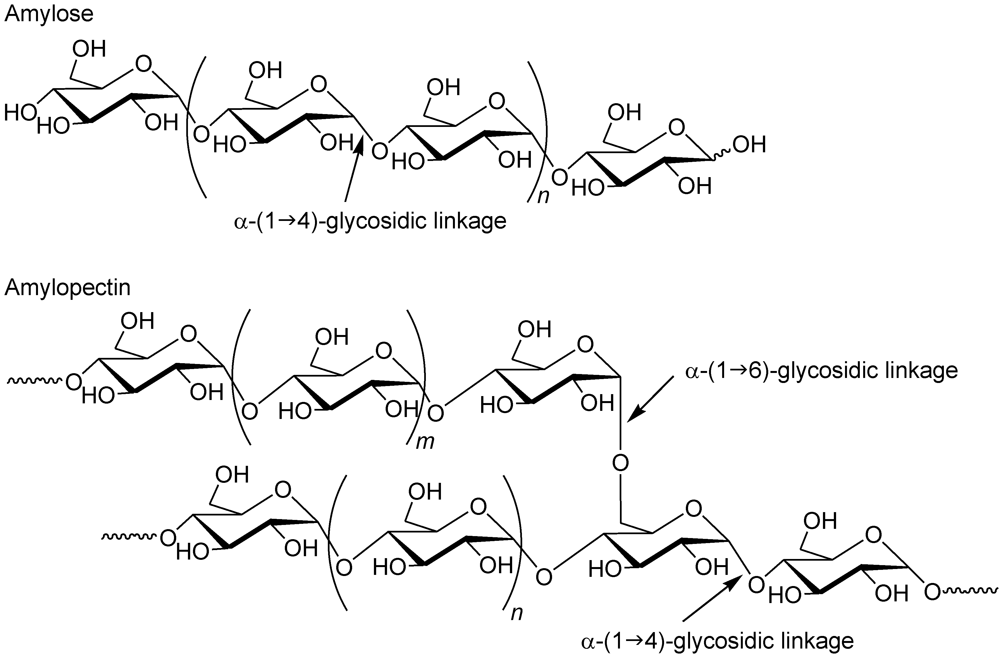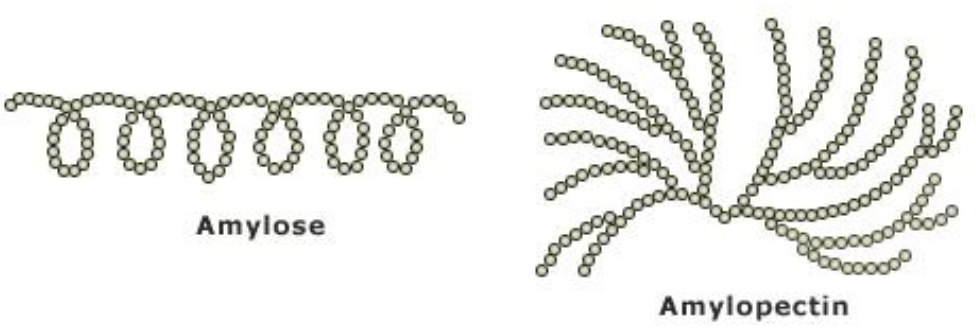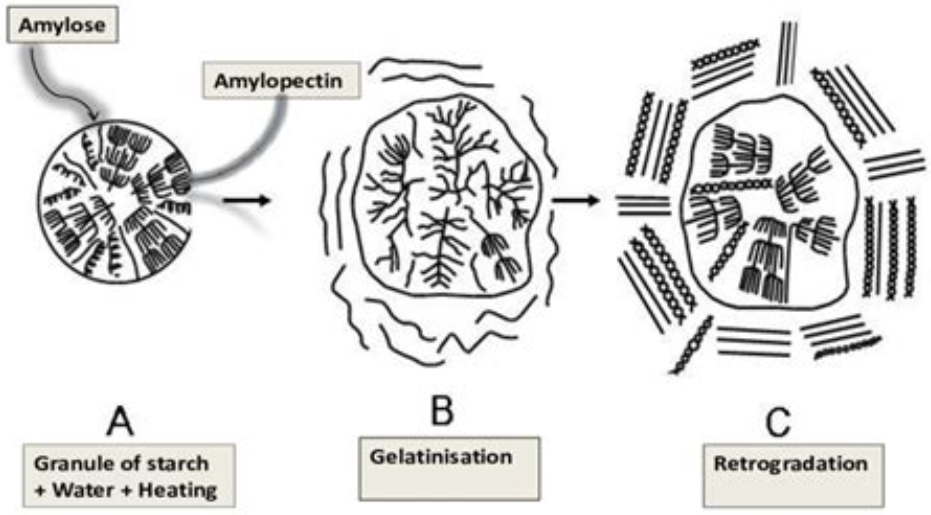Starch
2022-02-12 links: reference:
Starch #
Consists of Amylose and 70-80% Amylopectin:


- I’m not sure how they really interact together or if the molecules bind covalently. Starch appears to be one polymer, but it seems it’s mostly amylopectin with amylose weaving its way around or something:

- Indeed, neighboring chains form double helixes. As you can see, the α1,6 bonds are few and far between compared to α-1,4.
- Type A (cereals), B (raw potato, banana), and C (peas, beans) starch.
Resistant Starch #
- RS1: Physically protected. Found in whole grains, seeds, some legumes.
- RS2: Very compact and dehydrated. Found in raw potatoes, green bananas, some legumes, etc.
- RS3 (Retrograde RS): Formed via retrogradation, primarily of amylose.
- RS4: Chemically modified (like physically prepared) to resist digestion
- RS5: Starches that are complexed with lipids
- Specifically targeted for fermentation by the Butyrate-producing Bifido bacteria. As well as Propionate production.
- The presence of SCFAs in the hind Gut lowers the pH, softens stools, and increases stool bulk.
-
Effects of resistant starch on behaviour, satiety-related hormones and metabolites in growing pigs
- Triglyceride levels were higher in RS-fed than in PS-fed pigs. GLP-1 levels were lower (which is interesting since propionate increases GLP-1), blood serotonin was lower, MAO activity and trypwere higher, and more satiating.
-
Ruminococcus bromii is a keystone species for the degradation of resistant starch in the human colon
- R. bromii supplementation greatly enhances RS3 fermentation in vitro in the large intestine.
- Adhesion of Vibrio cholerae to Granular Starches
- Inhibits FMO3 (Flavin monooxygenase-3) which is associated with TMAO production
- Trimethylamine + NADPH + H+ + O2 <-> TMAO + NADP+ + H2O
Retrogradation #
-
The effect of various cooking methods on resistant starch content of foods
- While the resistant starch amount of boiled beans decreased while boiled chickpeas’ resistant starch amount increased. The reason for the decrease in resistant starch content in beans is the catabolism of amylose inhibitors that arises during the boiling; the increase in resistant starch content in chickpeas is explained with the retrogradation of starch that arises after boiling and gelatinization.
- Boiling lentils significantly increased the resistant starch content from 15.6–43.2 g/kg dry matter in the raw lentils to 37.3–50.9 g/kg dry matter in the cooked lentils due to retrogradation of starch after gelatinization.
- Boiling decreases the resistant starch content of potatoes from 69% to 1.2% whereas cooling after boiling increases such content by 4.6%. 4°C for 44 h) after boiling changed the resistant starch content of potato varieties from 3.9% to 7% dry matter basis due to retrogradation of amylose and amylopectin during processing
- Raatz et al. (2016) has compared RS content of potatoes by two different cooking methods (baking and boiling) and service temperatures (hot:65°C, chilled:4°C, and reheated:4°C for 6d and reheated to 65°C) and found that baked potatoes have more RS content than boiled ones. The use of heat treatment with moisture, shown to increase resistant starch formation with the cooking method baking, may explain the difference that observed with baking vs. boiling of the potatoes
- Higher Amylose starches become harder after cooling,
-
Effects of cooking methods and starch structures on starch hydrolysis rates of rice
- Higher onset gelatinization temperature.
-
Effects of cooking methods and starch structures on starch hydrolysis rates of rice
-

-

- Idrk what I’m looking at. Gelatinization is what is seen from heat + H2O, and it makes the granules more accessible to digestive enzymes. I don’t even know if this is what “cooking” consists of.
- When starch is heated in the presence of water and subsequently cooled, the disrupted amylose and amylopectin chains can gradually reassociate into a different ordered structure in a process termed retrogradation.
-
Starch Retrogradation: A Comprehensive Review
- Increased viscosity and turbidity of pastes, gel formation, exudation of water and increased degree of crystallinity with the appearance of B-type crystalline polymorphs pectively. For nonwaxy starch, retrogradation results in the transformation of a starch paste into a firm gel consisting of a 3-dimensional network.
- The hardness and springiness of retrograded starch gels increase during the initial stage of storage at a constant temperature, but then change only slightly on longer storage
- Glucose, ribose, fructose, sucrose (sometimes), maltose, and water-soluble maltodextrins all can retard starch retrogradation. Disaccharides seem to be more effective than monosaccharides, and there were a few cases where glucose and sucrose increase the rate.
- As well as β-Cyclodextrin, polysaccharides e.g. β-Glucan, and food additives like gum arabic, Carrageenan, Pectin, xanthan gum, guar gum.
- The addition of NaCl during processing or storage can alter greatly the extent of starch gelatinization and retrogradation.
- Lipids can interact with starch to form inclusion complexes by entrapment in the Amylose helical cavity: For different types of lipids, the shorter the fatty acid chain, the more effective retardation of starch retrogradation
- The addition of tea polyphenols to rice starch significantly retarded starch retrogradation in a concentration-dependent manner. Similarly, addition of the flavonoid rutin also greatly retarded the retrogradation of normal and high-amylose rice starches. The retrogradation of normal rice starch was completely inhibited by the addition of rutin
- NaCl should slow it down at refrigeration temps.
-
Starch Retrogradation: A Comprehensive Review